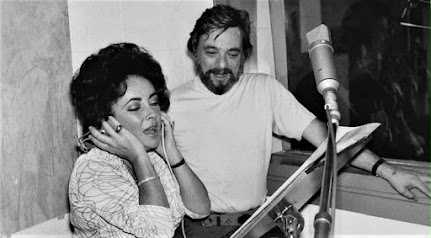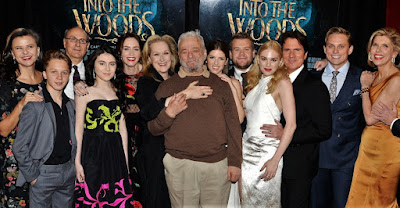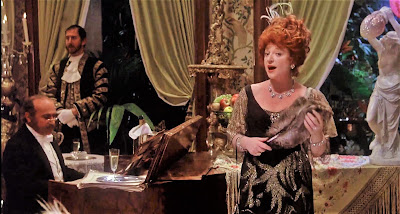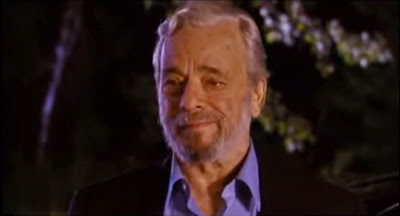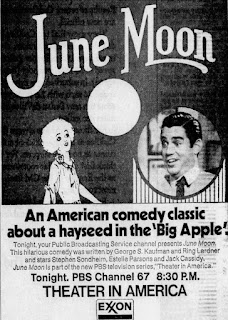Hello, Dolly!, indeed.
I’ve wanted to write about this movie since I started this blog way back in 2009.
The only thing preventing me was the promise I’d then made to myself—in response to what felt like (in the days of IMDb’s message boards and forums) a pervasive trend toward negativity and combativeness in online film writing and discourse—that I would devote this retro movie blog exclusively to the films I loved and admired most.
And when it comes to Hello, Dolly! ...well, let's just say my relationship with it is complicated.
.JPG) |
| Barbra Streisand as Dolly Levi |
.png) |
| Walter Matthau as Horace Vandergelder |
.png) |
| Michael Crawford as Cornelius Hackl |
.png) |
| Marianne McAndrew as Irene Molloy |
 |
| Danny Lockin as Barnaby Tucker |
 |
| E. J. (Edra Jean) Peaker as Minnie Fay |
 |
| Louis Armstrong as Louis, the Orchestra Leader |
Hello, Dolly! is the much-hyped, megamillion-dollar 1969 screen adaptation of that enduring, now-classic 1964 Tony Award-winning musical (with the annoying exclamation point) about a meddlesome matchmaker from Yonkers who sets her personal matrimonial sights on a curmudgeonly, wealthy client. I’m old enough to have seen Hello, Dolly! when it was released in December of 1969, but not being much of a Streisand fan at the time (that changed with 1972’s What’s Up, Doc?) I foolishly backed out of every opportunity to see it.
That was the winter when I, a precocious, self-serious, hormonal adolescent, was busy spending my weekends and most of my allowance money going to see Easy Rider, They Shoot Horses, Don’t They?, Midnight Cowboy, and The Sterile Cuckoo...over and over again. The last thing I was interested in was seeing anything rated “G.” Much less a G-rated thing that sang and danced.
Of course, now I could kick myself for not having given up at least one weekend of “Suggested for Mature Audiences” nihilism for the chance to experience the opulent excesses Hello, Dolly! on the big screen. More’s the pity because I just know that impressionable, 12-year-old me would have gone utterly gaga over the whole "event" spectacle that is Hello, Dolly!
 |
| If anyone can upstage 4,000 extras, it's Barbra Streisand |
I absolutely live for that moment in “Before the Parade Passes By” when Streisand, arms aloft, striding toward the camera, flanked on both sides by a red-jacketed marching band, brings herself to a theatrical halt to end all theatrical halts, dropping her arms and that big ol’ hat, grounding herself like a rocket before liftoff, then lets fly with that voice that soars to the heavens and shattering all the artificiality around her. It’s a genuine “goosebump moment” in a film with all too few.
My family lived in San Francisco in 1969, and Hello, Dolly! played in movie theaters for at least a year after its exclusive, reserved-seat, $ 4.50-a-ticket roadshow engagement ended (at which time it became available at “popular prices” in neighborhood theaters on weird-ass double bills with The Battle of Britain or The Kremlin Letter, of all things). But I didn’t get around to seeing Hello, Dolly! until 1974…when it was broadcast on TV, in cropped format, with commercials, on our family’s ginormous living room console. Not the most advantageous of circumstances under which to see my first Barbra Streisand musical, to be sure, but at least by this time, I was an interested party.
(1) Well, I loved Jerry Herman’s tuneful score (although the beautifully sung, written-for-the-screen ballad [a.k.a., shameless Oscar-nomination bid] “Love is Only Love” was, is, and will forever remain for me, a total slog).
(2) I enjoyed Michael Kidd’s strenuous “The word I think I’d use is athletic” choreography.
(3) And although Barbra Streisand’s Dolly Levi makes not a lick of sense to me in the context of the story and casting—I’m supposed to believe this young, glamorous, sexy, and vivacious firecracker of a woman is wasting her time meddling in the love lives of four vapid virgins and one grumpy old man?—I was nevertheless utterly charmed and entranced by her.
The movie itself…not so much.
As Hello, Dolly! is set in 1860, I've selected a quote from a 19th-century author (re: drawing-room entertainments of the day) that cannily echoes my thoughts on seeing it for the first time.
As I said, perhaps television wasn't the best showcase for a film of this scale, and likely influenced at least a part of my initial response to Hello Dolly!
For example, the film's lack of visual distinction (all static shots and overlit sets) was ill-served when subjected to the then-standard practice of cropping the edges of wide-screen movies to better fit the square TV screen. The sight of blandly colorless dancers with fixed, joyless smiles leaping about with mechanical precision in a New York set that, in the minimalized format of television, resembled nothing so much as Disneyland’s Main Street; didn’t scream "$25 million movie musical" so much as suggest a “The Doodletown Pipers Meet The Ernie Flatt Dancers" TV variety special.
While singing groups like The Doodletown Pipers and Up With People always gave off "cult" vibes to me, their popularity during the "let it all hang out" Sixties reflected a market for aggressively wholesome, MOR entertainment. Hello Dolly!, pitching itself as the family-friendly alternative to the saturated R and X-rated market of the New Hollywood, emerged as one of the top 5 highest-grossing films of 1969/70. (But, due to its hefty production and marketing budget, still wound up losing 20th Century Fox [depending on the source] in the neighborhood of 10 to 30 million dollars.)Given my penchant for falling in love with waaaaay less-than-perfect movies, none of the above-stated would have factored significantly in my feelings for Hello, Dolly! had I just felt something…ANYTHING…for the characters or the story. Outside of the allure of Dolly’s fin de siècle fabulousness, I had no love story to root for and no investment in anything that was going on. By the film’s two-hour mark, I found myself wishing Ambrose and Barnaby would run off together and that Dolly would hook up with one of the Harmonia Garden waiters.
In the end, I was so disappointed that so much money, talent, and obvious hard work hadn’t resulted in a movie that was more fun. Or even funny.
Despite my complaints and primarily due to the immense pleasure I derive from Streisand's The Three Faces of Eve take on the character of Dolly Levi (she's Mae West! She's Fanny Brice! She's a drag queen!...the fun to be had is in never knowing from scene to scene which Dolly is going to show up), I've always owned a copy of Hello, Dolly! and watched it countless times over the years. Usually à la carte...with the TV remote at the ready, finger poised over the "fast-forward" button.
So, how does a lifelong cinephile and movie musical lover reconcile himself to this paradox? Well, you take the good, you take the bad, you take them both, and there you have: Hello Dolly!…a film for which I’ve never fully resolved my love/hate feelings. (Thank you, Al Burton, Gloria Loring, and Alan Thicke.)
Until now.
The Matchmaker (1958), the screen adaptation of the 1954 Thornton Wilder Broadway play that inspired Hello, Dolly! The Matchmaker Cast: Shirley Booth, Shirley Maclaine, Paul Ford, Anthony Perkins, and Robert Morse
I had never even heard of The Matchmaker before seeing it on TCM sometime in 2001, but it instantly won me over with its abundance of heart, humor, engaging performances, and genuinely sweet-natured charm. The very things I’d always felt were missing in action from Hello, Dolly!. I initially thought that my falling in love with a practically-perfect-in-every-way adaptation of Wilder’s story would only amplify my dissatisfaction with Hello, Dolly!, but to my surprise, it had the opposite effect.
Finally seeing Thornton Wilder’s frothy farce presented on a scale appropriate to its slim plot and humble characters led me to conclude that perhaps part of my issue with Hello, Dolly! might stem from evaluating it by motion picture standards when it’s really not a movie at all; it’s a monument.
An eager-to-please, pull-out-the-stops, Barnum and Bailey Circus of a monument erected to commemorate and pay tribute to the institution that is Hello, Dolly!...a show that, at the time, was one of the most lauded (10 Tony Awards), lucrative, and long-running musicals in Broadway history.
Thinking of Hello, Dolly! this way has gradually turned me into a more appreciative audience. I once felt the film’s chief liability was its dogged devotion to the proved-to-be-fatal Hollywood dictum that bigger, busier, noisier, and more expensive was ALWAYS better. Now, simply because these qualities affix Hello, Dolly! squarely in a specific time and place in Hollywood history—the sets, costumes, production numbers, and sheer spectacle of it all shine brighter for me than they ever did.
On Feb. 29, 1968, a month before Hello, Dolly! began filming (and nine months after Streisand's casting), Carol Channing not-so-subtly thumbed her nose at 20th Century Fox while giving America a glimpse of what it stood to miss in the way of comedy chemistry by having Walter Matthau guest on her TV special.
As Broadway’s first singing Dolly (from 1964-1967), Carol Channing was so affectionately identified with the role that the casting of anyone else in the film version was bound to be controversial no matter who it was. But when news broke that the Hollywood parade had passed by 46-year-old Channing in favor of 25-year-old, hot-as-a-fuse Barbra Streisand—the very person Channing had beat out for Best Actress at the 1964 Tony Awards (Channing won for Hello, Dolly! against Streisand in Funny Girl)—the outcry over perceived miscasting turned it into a cause célèbre that raged unabated for over a year. |
| Billboard - May 9, 1964 |
Hello, Dolly! has often been dismissed as a "one-song musical" by critics. But when it comes to that one song, no one is more responsible for its widespread recognition and success than Louis Armstrong. His 1964 recording won Grammys for Best Song and Best Male Performance and gave the 62-year-old jazz legend his first and only #1 hit, famously dethroning The Beatles. I’ve always thought of Armstrong’s brief guest appearance in Hello Dolly! as one of the film’s few moments of magic. It’s the only moment in the entire film when Streisand looks relaxed and genuinely happy.

GOOD GOLLY, MISS DOLLY or: How I Learned to Stop Worrying and Love the Bomb
If part of my making peace with Hello, Dolly! means accepting that my heart will be on a bit of a starvation diet, I take comfort in knowing that—thanks to the modern innovations of Blu-ray, restoration, widescreen HD television, and impeccable digital audio—my eyes, ears, and nervous system will be treated to a veritable feast. Watching the title song production number and the breathtaking "Waiter's Gallop," I found myself feeling for the first time a sense of gratitude that Hello, Dolly! is such an overinflated totem of studio-era excess.
PERFORMANCES
Time has made the supporting cast of Hello, Dolly! less of an irritation to me (they're all so young, they're kind of cute now). Walter Matthau will ever be a favorite, his reactions and line deliveries being the source of many of the film's meager laughs: "Any man who comes to the city deserves what happens to him."
But I've often wondered if the creators of Hello, Dolly! didn’t fully recognize what a screen presence powerhouse they had in Barbra Streisand (Funny Girl hadn’t yet been released when "Dolly" went into production); otherwise, it's hard to understand why they didn’t see it as a problem that her character is offscreen for so long. The stage show is built to give an older actress lots of rest…but when you’re fortunate enough to have Streisand in a musical, do you really want to give so much screen time over to those dull ingenues and juveniles?
THE STUFF OF DREAMS
 |
| "I thought she did the BEST job she could do." - Carol Channing's slightly shady appraisal - Dec. 29, 1969 |
Perhaps because I don't think of Hello, Dolly! as a "great" musical in the first place (ergo, impervious to being "ruined" in any significant way), I don't have any problem with the built-in contradiction of my thinking Barbra Streisand is most definitely miscast as Dolly, yet I find her to be ideal as a musical comedy star. There's just no way I'd ever be disappointed to have one of the preeminent entertainers of my generation showcased in a vehicle like this. As unpleasant an experience as it was for Streisand in the making (as detailed in her EPIC memoir), I will be forever grateful that it exists. Streisand's not perfect in it...but in many ways, she's better than perfect, she's exquisite.
Hello, Dolly! is over 55 years old. Barbra Streisand is over 80. And I’m somewhere there in between. Sure, Hello, Dolly!, much like myself on certain mornings, can be lumbering and stiff. But just as I’ve found peace in not focusing on my aches and pains and learned to simply celebrate the fact that I’m still here, I'm glad—after so many years of back and forth—I can at last accord Dolly Levi a similar grace.
BONUS MATERIAL:
Gene Kelly puts his handprints in cement in the forecourt of Hollywood’s Grauman’s Chinese Theater on November 24, 1969, just prior to Hello Dolly!’s December 16th West Coast premiere.
The young ladies behind him are the stars of Fox's forthcoming X-rated release Beyond the Valley of the Dolls - Marcia McBroom and Cynthia Myers in Irene Sharaff-designed costumes from Hello, Dolly!.
During the '90s I worked for a time as Walter Matthau's personal trainer. After taking months to win over his confidence, he was finally comfortable enough with me to share some anecdotes about the making of "Dolly" after I begged to know the details. Without going into it, let me just say that in having heard the exact same story Streisand relates in her memoir more than 20 years before she wrote it, the talk about their not getting along during the filming is true (his recounting of the rude comment he made to her was accompanied by a surprisingly spot-on Streisand impersonation), as is the fact that they became good friends...or at least friendly...later.
The hemlines of women's skirts fluctuated rapidly in the 1960s, but it's got nothing on the 1890s, as evidenced by these screencaps of the "Dancing" sequence, showing Minnie Fay's dress growing shorter by the second.
 |
| Barnaby Tucker and Minnie Fay |
Two-time Tony Award winner Robert Morse made his Broadway debut at 24, originating the role of Barnaby Tucker in The Matchmaker, later reprising his performance in the film. In 1968, Morse co-starred with E.J. Peaker (24 when she made her screen debut in Hello, Dolly!) in the musical sitcom That's Life, which ran for a single season on ABC.
Richard Amsel, one of my all-time favorite illustrators, was just 21 and a recent art school graduate when his submission for 20th Century Fox's nationwide talent contest (to design a poster for Hello, Dolly!) was selected, launching his brief but prolific career. His iconic artwork for the Hello, Dolly! poster is noted for the era-specific, Boomer-recognizable Spirograph-style design of the flowers adorning Mrs. Levi's enormous hat.
Streisand & Matthau in a clip from Hello, Dolly!
Copyright © Ken Anderson 2009 - 2024





.png)

.JPG)






.jpg)



